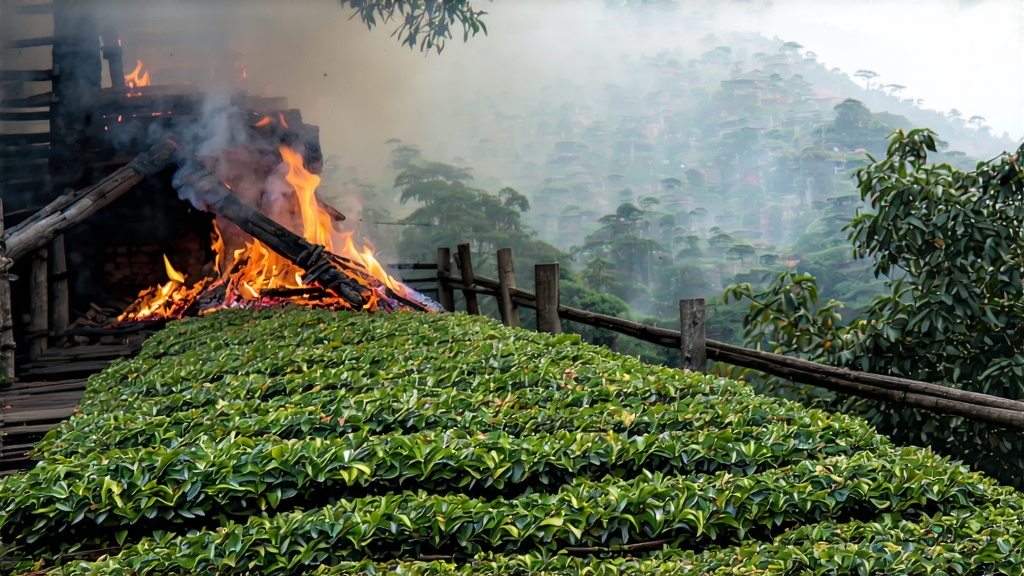
Ask most tea lovers to name the oldest black tea on Earth and they will answer with a single, musky-sweet syllable: Lapsang. Born in the precipitous Wuyi Shan of northern Fujian around 1646, Lapsang Souchong—literally “small-leaf variety from the original grove”—is the primogenitor of every keemun, assam, ceylon and breakfast blend that later conquered the world’s teacups. Yet its own story is far more intimate, wrapped in the resinous perfume of burning Masson pine and the mountain mist that Chinese poets once called “clouds you can drink.”
History: From Ming-Era Refuge to London Parlors
When Qing troops swept through Fujian, retreating Ming soldiers and local tea farmers sped up leaf-drying by firing fresh leaves over pinewood. The accidental smoke imprint traveled north with Dutch traders who christened it “bohea” (from the Wuyi cliffs) and sold it in Amsterdam for the price of silver. By 1669 the British East India Company listed “Lapsang” as a separate commodity; Samuel Pepys wrote of sipping “a kind of tea that tastes of tar and honey” while Charles II’s queen, Catherine of Braganza, used it to scent the royal chambers. Thus a wartime improvisation became the first Chinese black tea ever exported, predating keemun by almost two centuries.
Terroir: The National Park in a Cup
Authentic Lapsang Souchong can only come from the 600–1,200 m core zone of Wuyi’s national park, a UNESCO dual heritage site where subtropical evergreens grow out of vertical Danxia cliffs. Diurnal swings of 15 °C, mineral-rich red sandstone and a perpetual cloud cover force the bush to slow growth, concentrating sugars, amino acids and volatile oils. The indigenous cultivar—Xiao Zhong (small-leaf)—bears leaves barely 3 cm long, yet delivers a startling density of maltose and geraniol, the precursor to the tea’s signature lychee-like sweetness.
Two Families, Two Styles
- Traditional Smoke-Dried (Zheng Shan Xiao Zhong): Leaves wither over pine-wood fires inside a three-level wooden loft called a qing lou. After rolling they are pan-fired at 200 °C, then re-smoked for up to eight cycles. The finished strip is glossy black with golden tips; liquor glows amber, exhaling campfire, longan and sandalwood.
- Modern Unsmoked (Wu Yan Xiao Zhong): Responding to 21st-century demand for “clean” fruitiness, some makers omit smoking altogether, oxidizing leaves slowly in bamboo baskets to foreground cocoa, dried apricot and wild-flower honey. Purists argue it is no longer Lapsang; drinkers call it “Wuyi’s answer to Darjeeling.”
Craft: The Eight-Step Pine Ritual
- Pluck: one bud, two leaves before Qingming (early April) when dew still beads.
- Wither: 8–10 h on bamboo racks suspended above smouldering pinewood embers; moisture drops from 75 % to 45 %.
- Roll: 45 min of machine-assisted kneading ruptures cells, releasing catechins and polyphenol oxidase.
- Oxidize: leaves rest 3 h in cedar-lined crates; temperature 24 °C, humidity 80 %. Color shifts from jade to copper.
- Primary Smoke-Fire: wok temperature 220 °C; 3 min of tossing arrests oxidation while absorbing resin.
- Re-smoke: finished maocha is spread on wire mesh above slow-burning pine roots for six nightly cycles; each cycle lasts 40 min, followed by 20 min rest. Master smokers judge readiness by ear—when the crackle of escaping sap matches the rhythm of falling rain, the tea is done.
- Sort: vibrating sieves separate broken fannings; only whole leaves earn the name “Souchong.”
- Charcoal Bake: a final 70 °C bake over ember-free charcoal removes any surface moisture, fixing the signature tar-sweet perfume.
Chemistry in a Whiff
Gas-chromatography reveals 32 distinct phenols, the most charismatic being guaiacol and 4-methyl-guaiacol—molecules